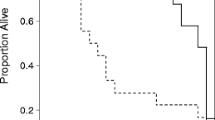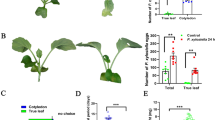Abstract
Neither toxins fromBacillus thuringiensis Berliner nor conspecific eggs deterred oviposition by the diamondback moth,Plutella xylostella (L.) (Lepidoptera: Plutellidae), in laboratory choice tests. The finding that toxins did not deter oviposition by moths from a susceptible line shows that oviposition preference and larval survival were not associated in this line. Selection for larval resistance to toxins did not significantly alter oviposition preference, which rules out a strong genetic correlation between larval performance and oviposition preference. Failure of conspecific eggs to deter oviposition may not represent lack of association of preference and performance because other evidence suggests that larval performance may not be greatly affected by larval density. These results suggest that the ability of refuges to slow evolution of physiological resistance toB. thuringiensis toxins will not be magnified by an oviposition preference for untreated foliage.
Similar content being viewed by others
References
Boulter, D., Gatehouse, J.A., Gatehouse, A.M.R., andHilder, V.A. 1990. Genetic engineering of plants for insect resistance.Endeavour 14:185–190.
Caprio, M.A., andTabashnik, B.E. 1992. Evolution of resistance to plant defensive chemicals in insects, pp. 179–215,in B.D. Roitberg and M. Isman (eds.). Evolutionary Perspectives in Chemical Ecology of Insects. Chapman & Hall, New York.
Chew, F.S. 1977. Coevolution of pierid butterflies and their cruciferous food plants. II. The distribution of eggs on potential food plants.Evolution 31:568–579.
Cohen, J. 1988. Statistical Power Analysis for the Behavioral Sciences, 2d ed. L. Erlbaum Associates, Hillsdale, New Jersey.
Dover, J.W. 1985. The responses of some Lepidoptera to labiate herb and white clover extracts.Entomol. Exp. Appl. 39:177–182.
Ferre, J., Real, M.D., Van Rie, J., Jansens, S., andPeferoen, M. 1991. Resistance to theBacillus thuringiensis bioinsecticide in a field populationPlutella xylostella is due to a change in a midgut membrane receptor.Proc. Natl. Acad. Sci U.S.A. 88:5119–5123.
Gasser, C.S., andFraley, R.T., 1989. Genetically engineering plants for crop improvement.Science 244:1293–1299.
Gould, F. 1991. Arthropod behavior and the efficacy of plant protectants.Annu. Rev. Entomol. 36:305–330.
Green, R.H. 1989. Power analysis and practical strategies for environmental monitoring.Environ. Res. 50:195–205.
Groeters, F.R.Tabashnik, B.E.,Finson, N., andJohnson, M.W. 1992. Fitness trade-offs in the evolution of resistance toBacillus thuringiensis by the diamondback moth (Plutella xylostella). Evolution submitted.
Gupta, P.D., andThorsteinson, J.A. 1960. Food plant relationships of the diamondback moth [Plutella maculipennis (Curt.)]. II Sensory regulation of oviposition of the adult female.Entomol. Exp. Appl. 3:305–314.
Harcourt, D.G. 1986. Population dynamics of the diamondback moth in southern Ontario, pp. 3–15,in N.S. Talekar (ed.). Diamondback Moth Management: Proceedings of the First International Workshop. Asian Vegetable Research and Development Center, Shanhua, Taiwan.
Hofte, H., andWhitely, H.R. 1989. Insecticidal crystal proteins ofBacillus thuringiensis.Microbiol. Rev. 53:242–255.
Jaenike, J. 1990. Host specialization in phytophagous insects.Annu. Rev. Ecol. Syst. 21:243–273.
Jaenike, J., andGrimaldi, D. 1983. Genetic variation for host preference within and among populations ofDrosophila tripunctata.Evolution 37:1023–1033.
Jaenike, J., andHolt, R.D. 1991. Genetic variation for habitat preference: Evidence and explanations.Am. Nat. I37:s67-s90.
Klunstra, J.W. 1986. The effect of oviposition deterring pheromone on egg laying inPieris brassicae.Entomol. Exp. Appl. 41:139–146.
Legg, D.E., Schenk, T.C., andChiang, H.C. 1986. European corn borer (Lepidoptera: Pyralidae) oviposition preference and survival on sunflower and com.Environ. Entomol. 15:631–634.
Reed, D.W., Pivnick, K.A., andUnderhill, E.W. 1989. Identification of chemical oviposition stimulants for the diamondback moth,Plutella xylostella, present in three species of Brassicaceae.Entomol. Exp. App. 53:277–286.
Rotenberry, J.T., andWiens, J.A. 1985. Statistical power analysis and community-wide patterns.Am. Nat. 125:164–168.
Rothschild, M., andSchoonhoven, L.M. 1977. Assessment of egg load byPieris brassicae, (Lepidoptera: Pieridae).Nature, 266:352–355.
SAS Institute 1985. SAS User's Guide: Statistics. SAS Institute Inc. Cary, North Carolina.
Schwartz, J.M., Tabashnik, B.E., andJohnson, M.W. 1991. Behavioral and physiological responses of susceptible and resistant diamondback moth larvae toBacillus thuringiensis.Entomol. Exp. Appl. 61:179–187.
Slansky, F., Jr., andRodriguez, J.G. (eds.) 1987. Nutritional Ecology of Insects, Mites, Spiders, and Related Invertebrates. John Wiley & Sons, New York.
Tabashnik, B.E. 1985. Deterrence of diamondback moth (Lepidoptera: Plutellidae) oviposition by plant compounds.Environ. Entomol. 14:575–578.
Tabashnik, B.E., andSlansky, F., Jr. 1987. Nutritional ecology of forb foliage-chewing insects, pp. 71–104,in F. Slansky, Jr. and J.G. Rodriguez (eds.). Nutritional Ecology of Insects, Mites, Spiders, and Related Invertebrates. John Wiley & Sons, New York.
Tabashnik, B.E., Gushing, N.L., Finson, N., andJohnson, M.W. 1990. Field development of resistance toBacillus thuringiensis in diamondback moth (Lepidoptera: Plutellidae).J. Econ. Entomol. 83:1671–1676.
Tabashnik, B.E., Finson, N., andJohnson, M.W. 1991. Managing resistance toBacillus thuringiensis: Lessons from the diamondback moth (Lepidoptera: Plutellidae).J. Econ. Entomol. 84:49–55.
Talekar, N.S. (ed.) 1986. Diamondback Moth Management: Proceedings of the First International Workshop. Asian Vegetable Research and Development Center, Shanhua, Taiwan.
Thompson, J.N. 1988. Evolutionary ecology of the relationship between oviposition preference and performance of offspring in phytophagous insects.Entomol. Exp. Appl. 47:3–14.
Thompson, J.N., andPellmyr, O. 1991. Evolution of oviposition behavior and host preference in Lepidoptera.Annu. Rev. Entomol. 36:65–89.
Via, S. 1990. Ecological genetics and host adaptation in herbivorous insects: The experimental study of evolution in natural and agricultural systems.Annu. Rev. Entomol. 35:421–446.
Wiklund, C. 1975. The evolutionary relationship between adult oviposition preferences and larval host plant range inPapilio machaon L.Oecologia 18:185–197.
Author information
Authors and Affiliations
Rights and permissions
About this article
Cite this article
Groeters, F.R., Tabashnik, B.E., Finson, N. et al. Oviposition preference of the diamondback moth (Plutella xylostelld) unaffected by the presence of conspecific eggs orBacillus thuringiensis . J Chem Ecol 18, 2353–2362 (1992). https://doi.org/10.1007/BF00984954
Received:
Accepted:
Issue Date:
DOI: https://doi.org/10.1007/BF00984954




